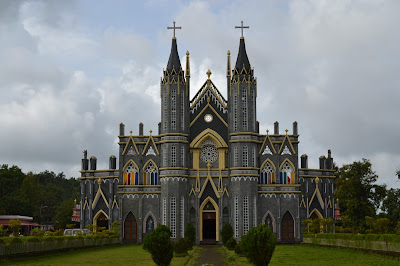 |
| St. Lawrence church, Karkala, Karnataka www.thehindu.com |
 |
| St. Lawrence statue, St. Lawrence church, Karkala, Karnataka |
The main preoccupation of this church is social activities and preaching of brotherhood essential for the various communities to live in peace to achieve success in their lives. The church is running an orphanage and a school. This church is dedicated to St. Lawrence who happened to be Spanish. St. Xystus, then the archdeacon of Rome, was very much impressed by Lawrence' s dedication to virtuous and righteous life and initiated him into learning the holy scriptures and the maxims of Christian perfection under his guidance.
 |
| St. Lawrence Church, at Karkala town in Karnataka planbox.wordpress.com |
The Roman ruler Emperor Valerian and his cronies were unfriendly, not god-fearing and took the tirade against the church. They had their eyes glued on the vast riches of the church. They wanted all the church heads put to death and Pope St. Xystus II was apprehended. Lawrence fulfilled the wish of Pope St. Xystus II and distributed the riches of the church, as wished by Xystus, among the poor. When the greedy ruler wanted St. Lawrence to produce the Church's riches, he at last, gathered all the unfortunate people of the society - the blind, the lame, the maimed, the lepers, orphans, widows, derelicts, etc. and invited the Prefect to come and examine the treasures of the Church and conducted him to the place. He emphasized that these people were the real treasures and not other treasures (meaning gold, jewellery and precious stones). The infuriated Prefect, in rage, put Lawrence to death through torture. The noblemen took up the martyr's body on their shoulders, and gave it an honorable burial in the Verna field, near the road to Tibur, on 10 August 258. Now it stands over his grave the Basilica of St. Lawrence.
As ill-luck would have it, the Christians of this place underwent untold misery and suffering under the ruler Tipu Sultan of Srirangapatna from 1784-1799 AD . The Christian captives were taken to Srirangapatna and the church at Attur was already damaged. Tipu Sultan was against the British rulers and had an unsubstantiated suspicion that the local Christians were ardent supports of the oppressive British rulers under the East India company and would be a threat to his regime,
 |
| St. Lawrence Church, at Karkala town in Karnataka www.panoramio.com |
In the year 1895 the parish priest, Rev. Fr. Frank Pereira , in order to cope with the unusual number of devotees visiting the church, specially organized Novenas and prayer services making them more and more useful to the visiting devotees. Then in the year 1900 Rev. Fr. Frank built a Church, facing the north. This Church was blessed and inaugurated on 22.01.1901 by the Vicar General, Very Rev. Mgr. Frachett.
Rev. Fr. Frank Pereira's successors too kept up their devotional church services and St. Lawrence of Attur has become popular for his astonishing power of intercession with God. The patronage of St. Lawrence of Attur has gone up over the past years. Without visiting the shrine, lots of devotees experience his powerful intercession. That, lots of pilgrims come to the place throughout the year and specially those during the feast days in the month of January, is a valid proof that St. Lawrence does not disappoint those who come to him in faith and devotion.
The Annual Festival popularly known as 'Attur Jatre (Festival)' is both a religious and cultural fete, as people from all faiths make a bee line to the church on this occasion. The Jatre (festival) that takes place every year during the last Tuesday, Wednesday and Thursday of January attract lakhs of devotees from many parts of Karnataka and other states.
Ref:
https://en.wikipedia.org/wiki/St._Lawrence_Shrine








.webp)
